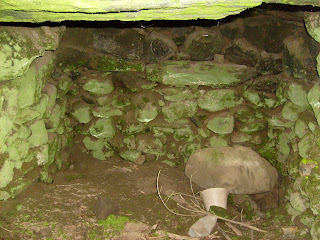I have a stone chamber on my property that I haven't found referenced anywhere online. It's located in Bethel VT on the Bethel-South Royalton town line on Royalton Hill Rd.
The chamber is built into an old stream bank and faces east. The dimensions are roughly 10' deep, 6' wide and 4'-6" high. The original height is probably more. The bottom is covered in large stones. I lifted one once and found an intact Saratoga Springs water glass bottle dated to ~1880 under it, so I'm assuming those stones were placed later.
The roof is comprised of three large slabs of stone running parallel, left to right. Each one is somewhere in the neighborhood of 3' x 8' x 8".
There is another stone chamber on the same side of the road in South Royalton, less than 1/4 mile away. That one is in the middle of a field perhaps a couple of hundred yards from the road. It's larger than mine, but I couldn't tell you the exact size.
Update: In a later email:
I stopped by the 2-door-down neighbor's house the other day. It's been at least 4 years since I saw the stone chamber there. The woman who answered the door is renting the house and gave me permission to look for it, but also stated that she wasn't aware of any stone chamber there. The field is pretty big, and I spent about 15 minutes looking without any luck. As I was walking back up, just behind the house was a pile of stones that looked like pieces of the slabs from the roof. I think the person who owns the property dug it up. This is the same person who put a trailer up in the once-beautiful field next door about 2 years ago. Sorry.
Update: In a later email:
I stopped by the 2-door-down neighbor's house the other day. It's been at least 4 years since I saw the stone chamber there. The woman who answered the door is renting the house and gave me permission to look for it, but also stated that she wasn't aware of any stone chamber there. The field is pretty big, and I spent about 15 minutes looking without any luck. As I was walking back up, just behind the house was a pile of stones that looked like pieces of the slabs from the roof. I think the person who owns the property dug it up. This is the same person who put a trailer up in the once-beautiful field next door about 2 years ago. Sorry.

































